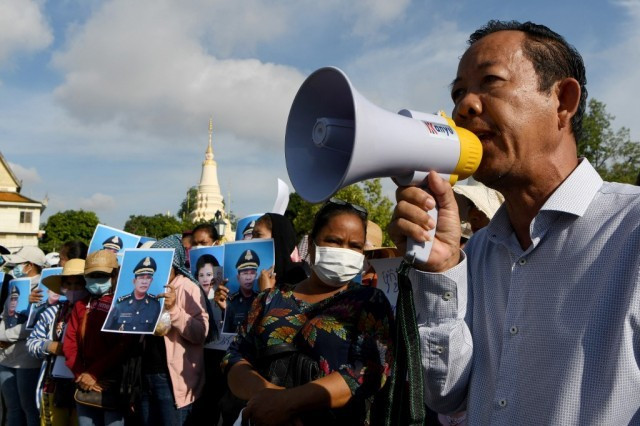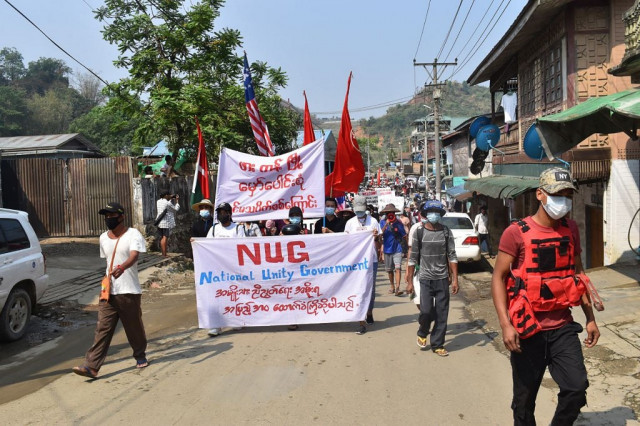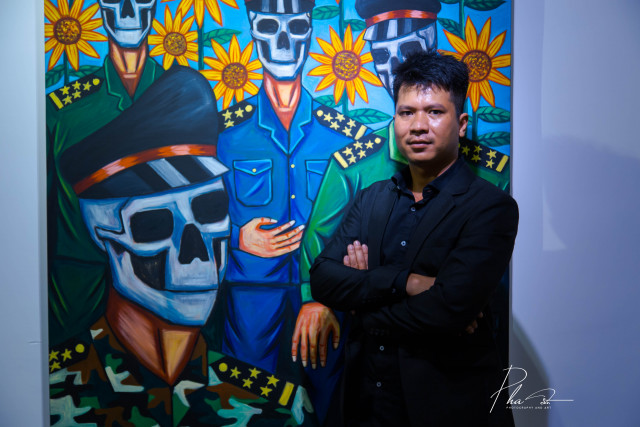Students Immortalize Vann Molyvann in a Sculpture to Mark the Architect’s Work for the Country
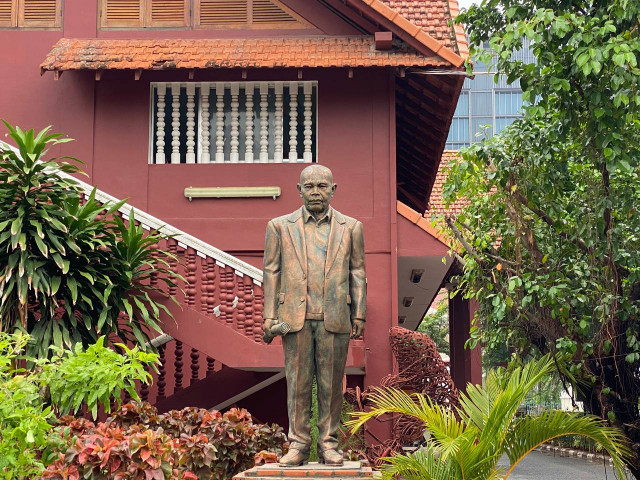
- By Teng Yalirozy
- October 22, 2022 4:32 PM
PHNOM PENH — A group of students from the Royal University of Fine Arts (RUFA) in Phnom Penh chose for their graduation project to make a sculpture of the late architect Vann Molyvann to highlight his legacy in the field and inspire today’s young architects and urban planners to design projects adapted to the country’s climate and living conditions.
Son Sichhem, Yin Samol, and Phea Chivan, respectively from Takeo province, Kandal province, and Prey Veng province, conceived and made the sculpture during their last year at RUFA to obtain their bachelor’s degree in Modern Sculpture at the Faculty of Fine Arts.
“He was the hero and the father of Khmer architecture,” said Sichhem of Vann Molyvann who also established RUFA and was its first rector.
On Oct. 20, 2022, the three students defended their project in front of their professors on RUFA’s campus grounds where their sculpture stood near the sculpture of the late King Norodom Sihanouk, which was the graduation work of students of previous years.
Dressed in formal appropriate suits and wearing the university’s red tie, the group began their defense at around 2 p.m. Phea Chivan first took the stage, explaining what their work was meant to reflect; Yim Samol then presented the late architect’s biography; and finally, Son Sichem described the material and techniques used to create the full-size sculpture of Vann Molyvann who passed away in 2017.
As Sichem also explained, his team decided to feature Vann Molyvann because they wanted their sculpture to be a reminder of this brilliant Cambodian architect for today’s Cambodian people and students.
Yin Samol, who is already a sculptor, said that they also made the sculpture to encourage today’s young architects and all Cambodians to aim to excel in what they do, to aim to be as good if not better than Vann Molyvann in order to produce more and promote Khmer architectural styles. “Everyone can sculpt but not all can give meaning to sculptures,” he said.
After the students’ presentation, the professors took turns asking questions. The group smoothly gave the answers to the first couple of questions. However, they struggled answering one question asked by a teacher: Why had they sculpted the architect when he was older. Yin Samol said that the only photos of the architect they could find on the internet were those in his later years. The teacher then said he should have responded that the older a person is, the wiser he is, the more experience he has accumulated.
The question-and-answer session lasted about 30 minutes. The three students graduated and their sculpture will remain on the university campus.
 Professor Sophon Samkhan, second from left, poses with the students—Phea Chivan, left, Son Sichhem and Yin Samol— he advised as they worked on their statue of Vann Molyvann seen behind them at the Royal University of Fine Arts. Photo: Teng Yalirozy
Professor Sophon Samkhan, second from left, poses with the students—Phea Chivan, left, Son Sichhem and Yin Samol— he advised as they worked on their statue of Vann Molyvann seen behind them at the Royal University of Fine Arts. Photo: Teng Yalirozy
Steps to creating the work
According to Sichhem, the sculpture was done by the three students at the home of one of their teachers and, while completing the work took about one month, the research and discussions that led to the final work had begun at the start of their last year at university.
They had many discussions with their professor guiding them as they created and altered sculptures before they agreed on a final work, he said.
Making the sculpture involved four steps, Sichhem said. The three artists began with the face they did in clay and put on a templet. Next, they prepared a steel frame and added cement. Then, after cleaning the surface of the work, they painted and colored the sculpture. Once done, the three artists brought it to university.
The three students did not really face challenges as their teachers were always there to advise and assist them, Sichhem said.
Immortalizing famed Cambodians for posterity
Sophon Samkhan, the sculpture professor at the Royal University of Fine Arts who guided the three students during their project, said that it is important for the next generations of Cambodians to know the father of Cambodia’s contemporary architecture as well as RUFA. “In order for the next generations to work hard, we must keep reminding them to strive to be like him.
“Like the temples of Angkor that our ancestors built, if we did not try to take care of those temples, they would lose their character and beauty,” Samkham said. “We, therefore, must protect and preserve [the work of renowned Cambodian individuals].”
There have been 28 classes of students who graduated in Modern Sculpture at RUFA’s Faculty of Fine Arts, he said. Students from each class must sculpt certain renowned individuals or any sculpture embedded with the meanings of obtaining their bachelor’s degree, Samkhan said.
So far, around 40 sculptures were done by the students, he said. Some of them have been placed on RUFA’s campus while others have been sent to ministries at the ministries’ request.
Young people who would like to become sculptors should attend school and university in order to do the work professionally as a sculpture is not about reproducing an image but about conveying meaning and history through the sculpture, Samkhan said.
For example, he said, “[y]ou can sculpt architect Vann Molyvann, but you don’t know his work and his biography. So, when we don’t know the sources of our sculptures, they will all become others.”
Born in 1926, Vann Molyvann was a Cambodian architect and urban planner during the Sangkum Reastr Niyum regime (1955-1970) of the late King Norodom Sihanouk. Molyvann was the first of a generation of architects who made significant contributions to the distinctive architectural style known as New Khmer Architecture, which emerged during that era.
In 1965, King Norodom Sihanouk—who held the title of prince at the time—gave Vann Molyvann the task of transforming the Ecole des arts cambodgiens—School of Cambodian arts—founded around 1917 into the Royal University of Fine Arts.
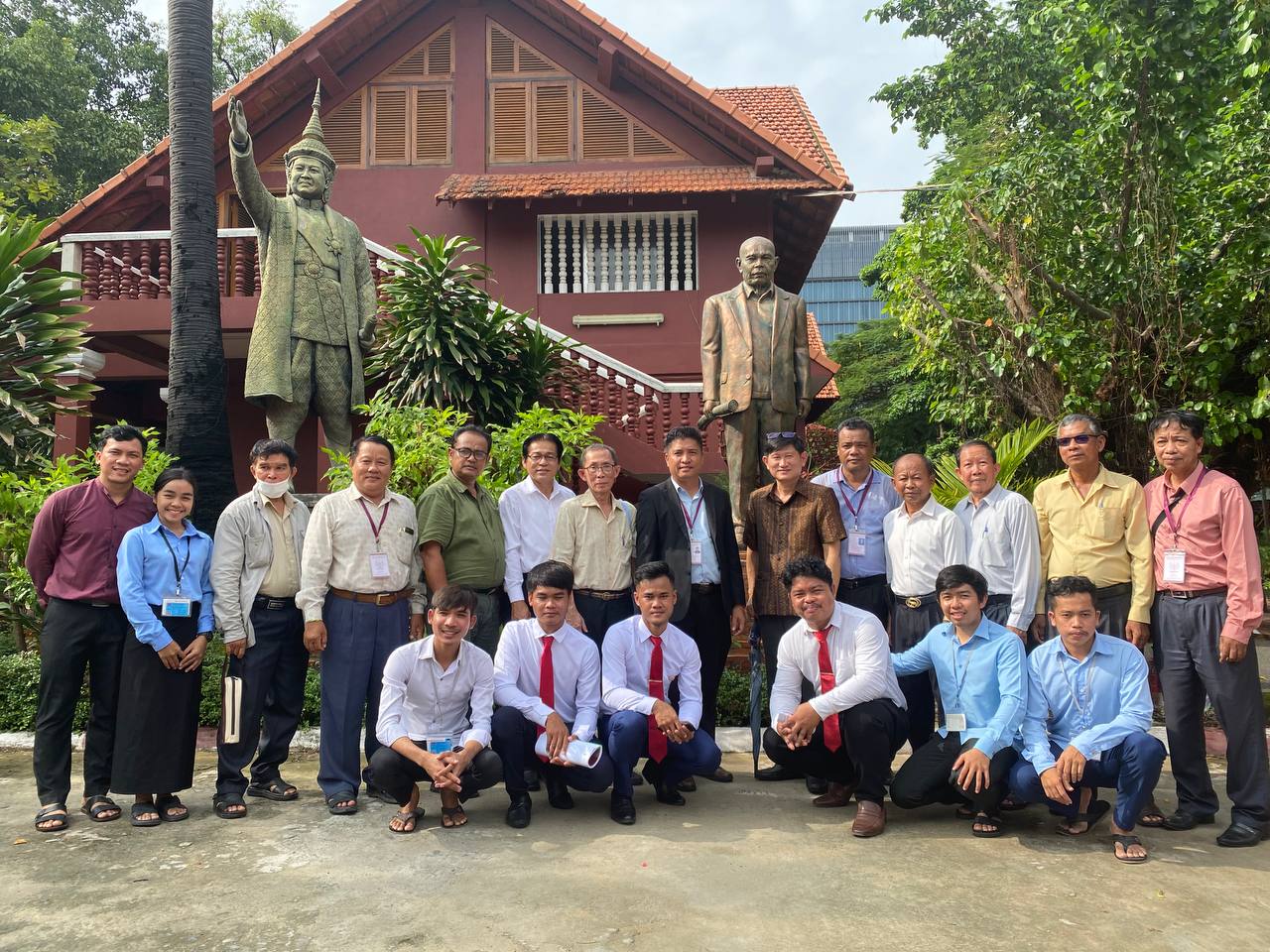 Teachers and students—most of them from the graduating class of 2022—pose next to the statues of the late King Norodom Sihanouk, left, and the late Vann Molyvann on the campus of the Royal University of Fine Arts in Phnom Penh. Photo: Teng Yalirozy
Teachers and students—most of them from the graduating class of 2022—pose next to the statues of the late King Norodom Sihanouk, left, and the late Vann Molyvann on the campus of the Royal University of Fine Arts in Phnom Penh. Photo: Teng Yalirozy






